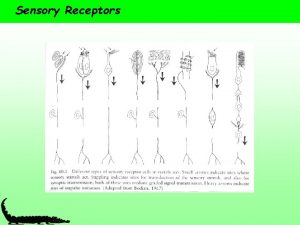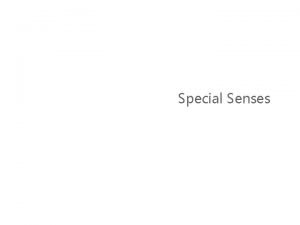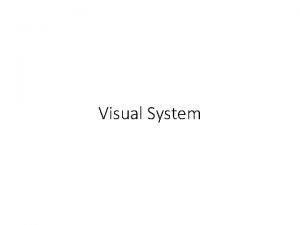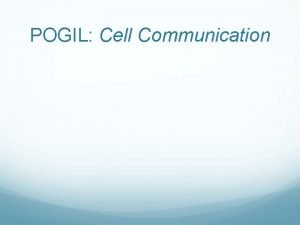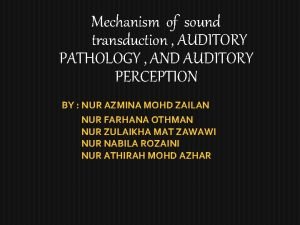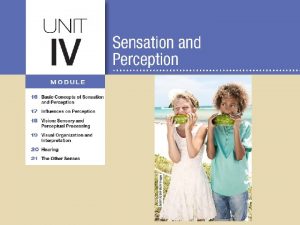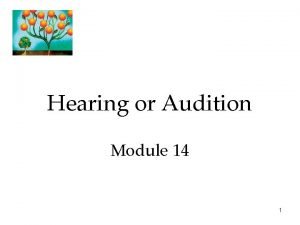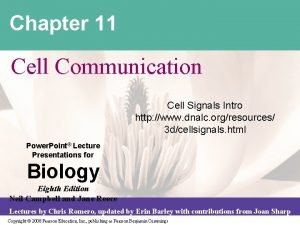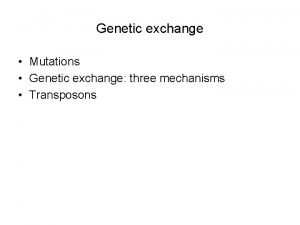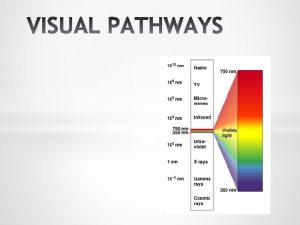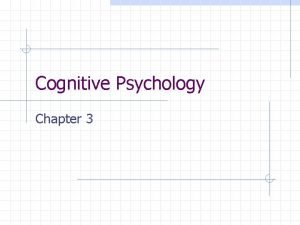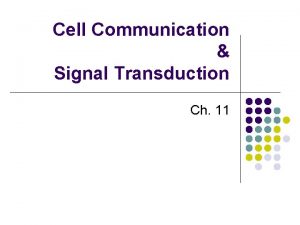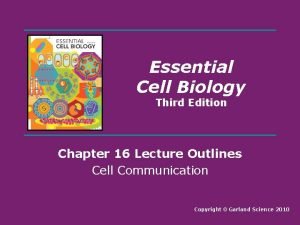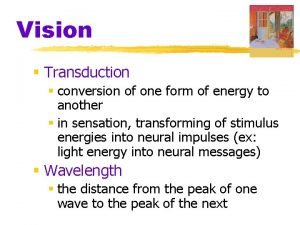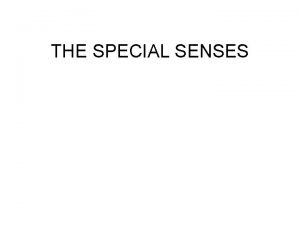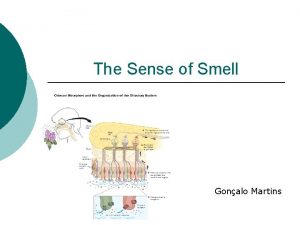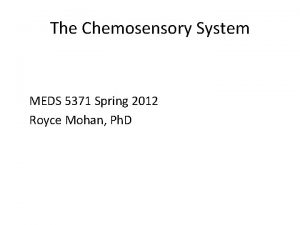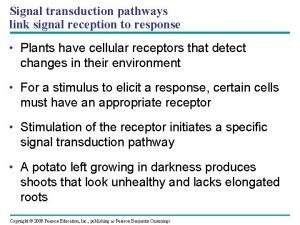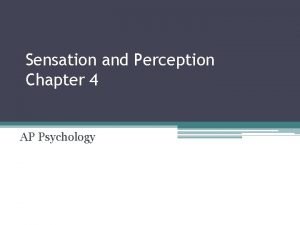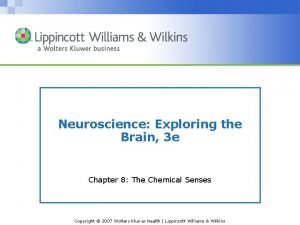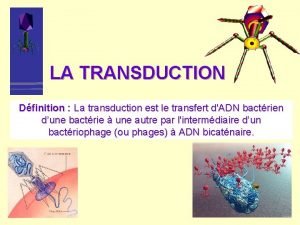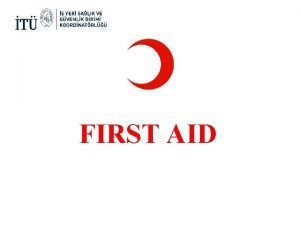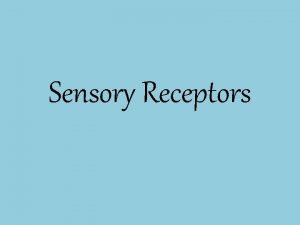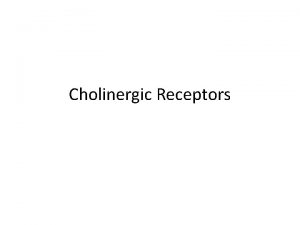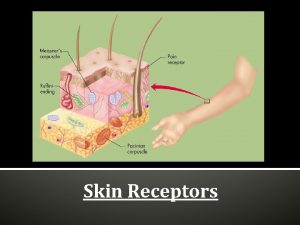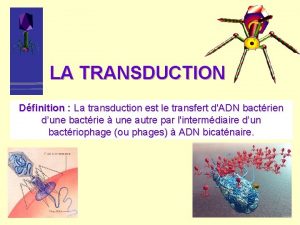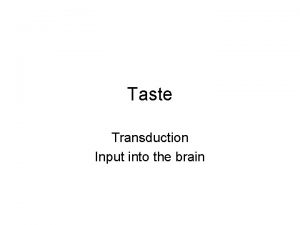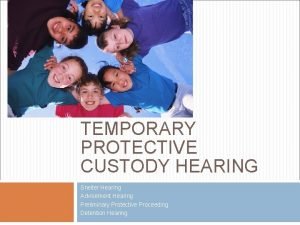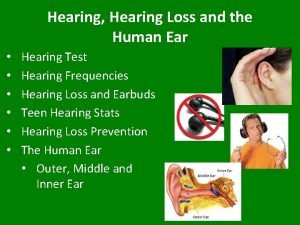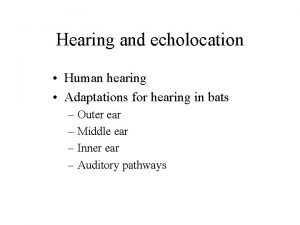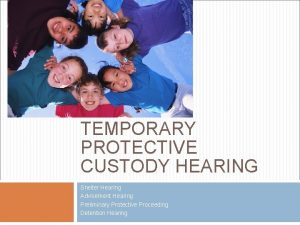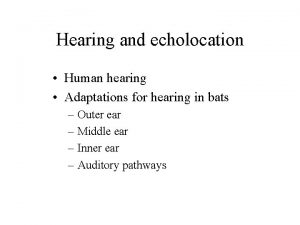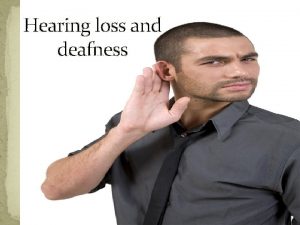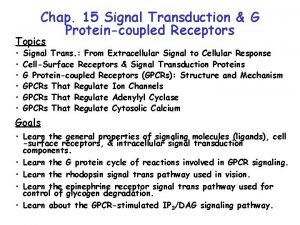Hearing physiology Receptors physiology Energy transduction First goal



























- Slides: 27

Hearing: physiology

Receptors / physiology Energy transduction ● First goal of a sensory/perceptual system? ● Transduce environmental energy into neural energy (or energy that can be interpreted by perceptual system). ● In hearing, environmental energy = pressure or sound waves. ●

Energy Transduction (cont. ) ● Pressure / Sound waves ●

● Energy Transduction (cont. ) ● Pressure / Sound waves ● When people create a wave, it looks like this: ● When air molecules do, it looks like this: (Animations courtesy of Dr. Dan Russell, Kettering University)

● Energy Transduction (cont. ) ● Pressure / Sound waves (cont. ) ● We can create a graph of pressure at different locations in space:

Energy Transduction (cont. ) ● Pressure / Sound waves (cont. ) ● Amplitude (loudness) ● Loudness is measured by how much the air molecules are compressed after the sound starts, ● ● while frequency (pitch) is measured by how long it takes the wave to finish a complete cycle.

● Energy Transduction (cont. ) ● Pressure / Sound waves (cont. ) ● Humans hear tones with frequencies from 2020, 000 Hz. Highest sensitivity in 2000 -5000 range. (Baby cry) ●Most tones aren't pure tones, like those in previous slides, they're complex tones:

Anatomy of the ear: outer ear, middle ear, inner ear ●

Anatomy of the ear: outer ear, middle ear, inner ear ● Outer ear ● pinna: part you see; amplifies sounds around 400 hz; plays a role in sound localization ● auditory canal: cylindrical tube; conducts vibrations to eardrum; acts like a horn amplifies sound (esp. around 3000 hz) ● eardrum (tympanic membrane): pressure waves are converted into mechanical motion ●

● Anatomy of the ear: outer ear, middle ear, inner ear ● Middle ear

Anatomy of the ear: outer ear, middle ear, inner ear ● Middle ear (cont. ) ● ossicles : malleus (hammer), incus (anvil), stapes (stirrup). ● conduct vibrations from eardrum to oval window ● more amplification ● muscles attached to the ossicles can retract reflexively if loud, low frequency sounds are heard, reducing amplitudes at levels that might cause hearing damage. ●

● Anatomy of the ear: outer ear, middle ear, inner ear ● Middle ear (cont. ) ● eustachian tube : ossicles are surrounded by air; important to keep pressure in middle ear the same as pressure outside; otherwise eardrum would stiffen and become less responsive. ● ● ● E. tubes go to throat, open every time we swallow, equalizing pressure. A cold can block tubes, resulting in hearing loss (usually temporary). Infection can be transmitted through E. tubes, esp. in children, causing fluid buildup - eardrum can bulge or even burst.

● Anatomy of the ear: outer ear, middle ear, inner ear ● Middle ear (cont. ) ● Bones of the middle ear are necessary because of the problem of impedance mismatch. That is, sound doesn't conduct well between air & water most sound will be reflected back. ● Middle ear problems (conduction deafness) ● ● ● ear drum punctured ear infection - fluid or solid build up in auditory canal. otosclerosis - stiffens stapes so won't function.

● Anatomy of the ear: outer ear, middle ear, inner ear ● Inner ear

● Anatomy of the ear: outer ear, middle ear, inner ear ● Inner ear (cont. ) ● semicircular canals : Already discussed - used for determining orientation, not hearing ● oval window 1/15 th area of eardrum; helps increase pressure & deal with impedance mismatch problem. ● cochlea : snail-shell-like structure; contains auditory receptors that transduce sound into neural signals.

● Anatomy of the ear: outer ear, middle ear, inner ear ● Inner ear (cont. )

Anatomy of the ear: outer ear, middle ear, inner ear ● ● Inner ear (cont. ) ● vestibular canal: next to oval window; liquid is set in motion here; vibrates reissner's membrane. ● tympanic canal: connected to vestibular canal via helicotrema (basically a small hole). Vibrates basilar membrane. ● cochlear duct: separate canal, contains organ of corti.

● Anatomy of the ear: outer ear, middle ear, inner ear ● Inner ear (cont. ) ● basilar membrane : When pressure is applied to vestibular & tympanic canals, basilar membrane becomes distorted - creating a traveling wave

● Anatomy of the ear: outer ear, middle ear, inner ear ● Inner ear (cont. ) ● basilar membrane (cont. ) ● Traveling wave Because of the traveling wave, the basilar membrane vibrates differently depending on tone of sound stimulating it. ●

● Anatomy of the ear: outer ear, middle ear, inner ear ● Inner ear (cont. ) ● organ of corti : contains hair cell receptors that rest between basilar membrane & tectorial membrane. ● hair cells : receptors that cause cell to fire when tips are bent.

● Anatomy of the ear: outer ear, middle ear, inner ear ● Inner ear (cont. ) ● When basilar membrane is displaced, hair cells are bent by tectorial membrane; when a hair cell is stimulated, its neuron fires.

● Anatomy of the ear: outer ear, middle ear, inner ear ● Inner ear (cont. ) ● inner ear problems - nerve deafness ● hair cells damaged or broken - can cause tinnitus, or ringing in the ears, other problems ● cochlear implants - can essentially replace a cochlea for people who have damage for any number of reasons. The implant breaks sounds into component frequencies & then stimulates auditory nerve, much as cochlea would.

● Anatomy of the ear: outer ear, middle ear, inner ear ● Inner ear (cont. ) ● Bone conduction: alternate way of transmitting sound to inner ear. ● sounds produce vibration in skull that stimulates inner ear directly (bypassing middle ear) - usually only low frequencies. ● ex: chewing on food; dentists drill ● explains why your voice sounds different on tape.

● Brain and auditory cortex

● Brain and auditory cortex ● auditory nerve : carries info from ear to cortex. Different auditory neurons are sensitive to different frequency tones; frequency tuning curves:

● Brain and auditory cortex ● Cochlear nucleus: First stop; transmits half info to same side of brain, and half to opposite side. (allows binaural processing) ● inferior & superior colliculus : Superior colliculus involved in integration of vision & audition. I. C. Has tonotopic organization, meaning neurons sensitive to similar tones are found near each other. ● auditory cortex : Still tonotopic, some cells require more complex stimuli (than mere pure tones) to become active; clicks, bursts of noise, etc.

List of terms, section 3 ● Transduction ● Helicotrema ● Pressure/Sound waves ● Cochlear duct ● Amplitude (loudness) ● Organ of Corti ● Compression, rarefaction ● Basilar membrane ● Frequency (pitch) ● Traveling wave ● Wavelength ● Hair cells ● Pure tone, complex tone ● Tectorial membrane ● Pinna ● Tinnitus ● Auditory canal ● Nerve deafness/ Conduction deafness ● Eardrum/tympanic membrane ● Cochlear implants ● Ossicles ● Bone conduction ● Malleus, Incus, Stapes ● Auditory Nerve ● Eustachian tube ● Frequency tuning curve ● Impedence mismatch ● Cochlear nucleus ● Otosclerosis ● Superior/Inferior colliculus ● Oval window ● Auditory cortex ● Vestibular Canal ● Tonotopic organization
 Classification of sensory receptors
Classification of sensory receptors Hearing and equilibrium
Hearing and equilibrium Houses the receptors for hearing
Houses the receptors for hearing Sensory transduction
Sensory transduction Pogil cellular communication
Pogil cellular communication Transduction in the ear
Transduction in the ear Where does transduction occur in the ear
Where does transduction occur in the ear Theories of hearing
Theories of hearing Dot
Dot Generalized transduction
Generalized transduction Fovea
Fovea Transduction cognitive psychology
Transduction cognitive psychology Cell signal transduction
Cell signal transduction Cell chapter 16
Cell chapter 16 Signal transduction
Signal transduction Transduction psychology
Transduction psychology Olfactory transduction
Olfactory transduction Olfactory transduction
Olfactory transduction Olfactory transduction
Olfactory transduction Signal transduction
Signal transduction Reception transduction response
Reception transduction response What is subliminal
What is subliminal Olfactory transduction
Olfactory transduction Transduction def
Transduction def Energy energy transfer and general energy analysis
Energy energy transfer and general energy analysis Energy energy transfer and general energy analysis
Energy energy transfer and general energy analysis Which is objective of first aid
Which is objective of first aid What was the goal of the first continental congress?
What was the goal of the first continental congress?
